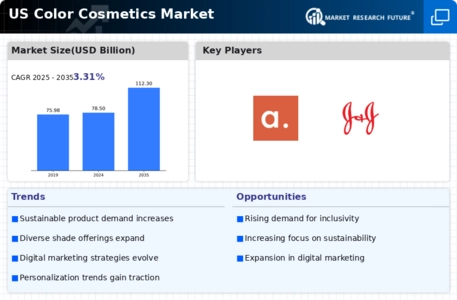Market Analysis
In-depth Analysis of US Color Cosmetics Market Industry Landscape
The US color cosmetics market is in a constant state of evolution, influenced by a myriad of factors that shape consumer preferences, industry trends, and technological advancements. With a diverse consumer base seeking a wide range of makeup products, the market dynamics are characterized by a delicate interplay of innovation, brand strategies, regulatory considerations, and shifting beauty standards.
Consumer preferences play a pivotal role in steering the dynamics of the US color cosmetics market. The demand for makeup products varies across age groups, ethnicities, and cultural backgrounds, leading to a diverse and dynamic landscape. Millennials and Gen Z consumers, in particular, have been instrumental in driving trends toward bold and experimental makeup looks, influencing the industry to produce a variety of vibrant and unconventional color options. This has prompted cosmetic companies to focus on inclusivity, offering a broad spectrum of shades to cater to the diverse needs of consumers.
The rapid pace of technological advancements contributes significantly to the dynamic nature of the color cosmetics market. Innovations in formulation techniques, packaging designs, and application methods have revolutionized the industry. The advent of augmented reality (AR) and virtual try-on technologies has further transformed the consumer experience, allowing individuals to virtually test products before making a purchase. This digital integration has not only enhanced the overall shopping experience but also impacted how brands market and sell their color cosmetic products.
Regulatory considerations and a growing emphasis on clean beauty and sustainability are shaping the market dynamics of color cosmetics in the US. Consumers are increasingly mindful of the ingredients used in cosmetic formulations, leading to a rise in demand for products that are free from harmful chemicals and cruelty-free. This shift has prompted cosmetic companies to adopt eco-friendly packaging, explore sustainable sourcing, and prioritize transparency in labeling. Regulatory agencies, such as the Food and Drug Administration (FDA), continue to play a critical role in setting standards and ensuring the safety of cosmetic products.
The competitive landscape fosters innovation and diversity in color cosmetic offerings. Beauty brands are constantly vying for consumer attention by introducing new and unique formulations, collaborating with influencers, and leveraging social media platforms for marketing. Limited-edition releases, themed collections, and constant product innovation have become strategies to keep consumers engaged and interested in the dynamic world of color cosmetics.
E-commerce has emerged as a significant channel in the distribution of color cosmetics, profoundly impacting market dynamics. The rise of online beauty retailers and direct-to-consumer models has altered how consumers discover, purchase, and experience cosmetic products. This shift requires cosmetic companies to invest in engaging online platforms, user-friendly websites, and effective digital marketing strategies to remain competitive in the rapidly evolving online marketplace.
Socio-economic factors, including economic trends, cultural influences, and lifestyle changes, contribute to the market dynamics of color cosmetics in the US. Economic prosperity often correlates with increased consumer spending on beauty products, while cultural shifts and evolving lifestyles influence the demand for specific makeup trends. As consumers seek products that align with their values and express individuality, cosmetic companies must stay attuned to these socio-economic factors to remain relevant and responsive to changing preferences.





Leave a Comment